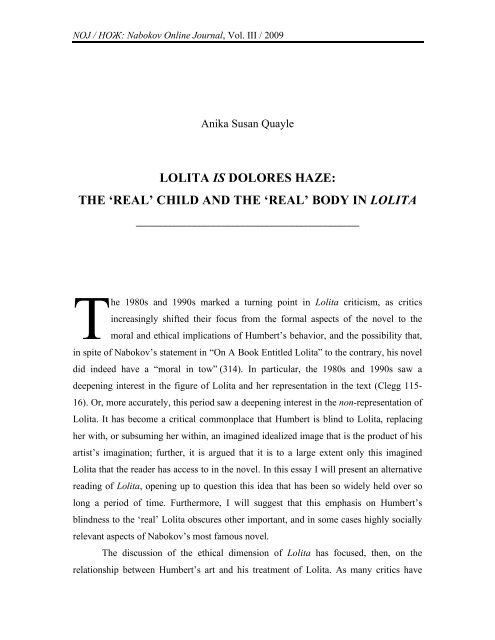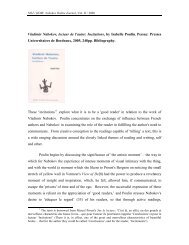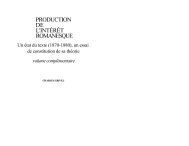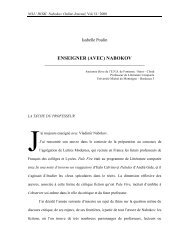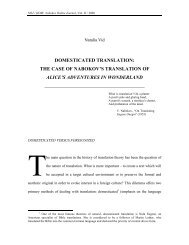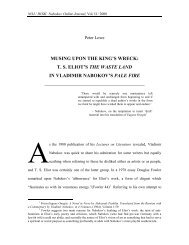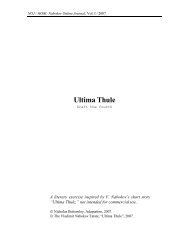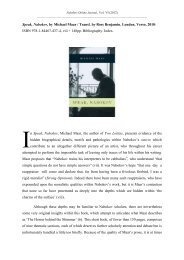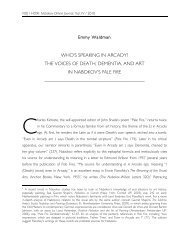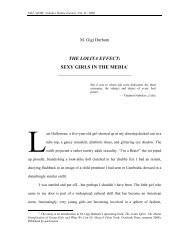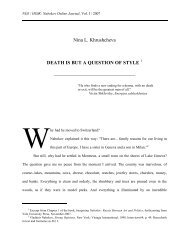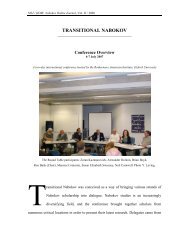LOLITA IS DOLORES HAZE: THE 'REAL' CHILD AND THE 'REAL ...
LOLITA IS DOLORES HAZE: THE 'REAL' CHILD AND THE 'REAL ...
LOLITA IS DOLORES HAZE: THE 'REAL' CHILD AND THE 'REAL ...
You also want an ePaper? Increase the reach of your titles
YUMPU automatically turns print PDFs into web optimized ePapers that Google loves.
NOJ / НОЖ: Nabokov Online Journal, Vol. III / 2009<br />
Anika Susan Quayle<br />
<strong>LOLITA</strong> <strong>IS</strong> <strong>DOLORES</strong> <strong>HAZE</strong>:<br />
<strong>THE</strong> ‘REAL’ <strong>CHILD</strong> <strong>AND</strong> <strong>THE</strong> ‘REAL’ BODY IN <strong>LOLITA</strong><br />
______________________________________________<br />
T<br />
he 1980s and 1990s marked a turning point in Lolita criticism, as critics<br />
increasingly shifted their focus from the formal aspects of the novel to the<br />
moral and ethical implications of Humbert’s behavior, and the possibility that,<br />
in spite of Nabokov’s statement in “On A Book Entitled Lolita” to the contrary, his novel<br />
did indeed have a “moral in tow” (314). In particular, the 1980s and 1990s saw a<br />
deepening interest in the figure of Lolita and her representation in the text (Clegg 115-<br />
16). Or, more accurately, this period saw a deepening interest in the non-representation of<br />
Lolita. It has become a critical commonplace that Humbert is blind to Lolita, replacing<br />
her with, or subsuming her within, an imagined idealized image that is the product of his<br />
artist’s imagination; further, it is argued that it is to a large extent only this imagined<br />
Lolita that the reader has access to in the novel. In this essay I will present an alternative<br />
reading of Lolita, opening up to question this idea that has been so widely held over so<br />
long a period of time. Furthermore, I will suggest that this emphasis on Humbert’s<br />
blindness to the ‘real’ Lolita obscures other important, and in some cases highly socially<br />
relevant aspects of Nabokov’s most famous novel.<br />
The discussion of the ethical dimension of Lolita has focused, then, on the<br />
relationship between Humbert’s art and his treatment of Lolita. As many critics have
A. Quayle. Lolita Is Dolores Haze<br />
noted, at various points in the novel Humbert suggests that his obsession with Lolita and<br />
his actions towards her are artistic in nature, affording him aesthetic, as opposed to<br />
carnal, bliss. For example, in describing himself on the night of his stay at The Enchanted<br />
Hunters Hotel, contemplating the rape of the unconscious Lolita, Humbert writes:<br />
If I dwell at length on the tremors and gropings of that distant night, it is because<br />
I insist upon proving that I am not, and never was, and never could have been, a<br />
brutal scoundrel. The gentle and dreamy regions through which I crept were the<br />
patrimonies of poets – not crime’s prowling ground. (131) 1<br />
He also writes that the reason he does not describe his first sexual encounter with<br />
Lolita in detail is that, “I am not concerned with so-called ‘sex’ at all. Anybody can<br />
imagine those elements of animality. A greater endeavor lures me on: to fix once for all<br />
the perilous magic of nymphets” (134). Many critics have taken strong exception to what<br />
they read as Humbert’s attempts to justify his behavior by suggesting that his aesthetic<br />
bliss should be considered apart from, and above, common morality, and that any damage<br />
inflicted upon Lolita is justified by the aesthetic pleasure produced. They have also<br />
suggested that Nabokov intended for the reader to view this critically. For example,<br />
Linda Kauffman argues that Nabokov intends to communicate to the reader that<br />
“[a]esthetic bliss is not a criterion that compensates for those crimes; instead it is a dead<br />
end, meager consolation for the murder of Lolita’s childhood” (163; see also Kauffman<br />
151-66; Pifer 166). The majority of critics also summarily – and, I believe, correctly –<br />
dismiss as false Humbert’s claim that his interest in art is separate from, or precludes, an<br />
interest in sex. Again, Linda Kauffman strongly makes this point when she writes that<br />
“Humbert’s sexual craving compels him to abuse Lolita” (162; see also Sharpe 61-2;<br />
Phelan, “Living” 100, 108). Nonetheless, most critics have entertained Humbert’s<br />
arguments to the extent that, if they do not see his interest in art as precluding an interest<br />
in sex or as justifying his sexual acts with Lolita, they do see art and sex as inextricably<br />
intertwined for Humbert – almost without exception critics have viewed Humbert’s<br />
interest, including his erotic interest, in Lolita as in some sense driven by art and by his<br />
artistic imagination.<br />
1 All references to Lolita are to: Nabokov, Vladimir. Lolita. London: Penguin Books, 1995.
NOJ / НОЖ: Nabokov Online Journal, Vol. III / 2009<br />
As John Haegert notes, it is a critical commonplace to read Lolita as a book in<br />
which Humbert subordinates everything around him to his private vision – it is argued<br />
that he empties not only people, but also objects and even landscapes of their individual<br />
identities, seeing them instead in whatever manner best suits his needs (Haegert 138). 2 In<br />
particular, it is a critical commonplace to argue that this is what Humbert does to Lolita:<br />
it is commonly argued that Humbert is obsessed, not with Lolita herself, but with an<br />
idealized vision or image of her that is in fact a creation of his artistic imagination.<br />
Further, it is argued that Humbert is so consumed by and focused on this imagined artistic<br />
image that it obscures the ‘real’ girl for him; it is suggested that – at least until the end of<br />
the text, and except in small glimpses – Humbert has no awareness of Lolita’s true<br />
thoughts, feelings, consciousness, or identity as an individual. 3 A particularly well-known<br />
proponent of this view is, again, Linda Kauffman, who writes, “From beginning to end,<br />
she remains an enigma to him... Lolita does not exist for Humbert precisely because he<br />
fails to imagine her except as a projection of his desires” (150, 155). Similarly, Michael<br />
Wood argues that “The ‘actual’ Lolita is the person we see Humbert can’t see” (117; see<br />
also 115-16). Indeed, variations on this argument can be found in the work of the vast<br />
majority of critics who have written on any aspect of Lolita in the last twenty years or<br />
more. 4 Furthermore, it is suggested by the majority of critics that it is Humbert’s<br />
blindness to the ‘real’ Lolita that leads or enables him to act in the way he does in relation<br />
to her. The most common argument is that Humbert is so intent on his alternative vision<br />
that he fails to notice the ‘real’ child’s suffering (see, for example, Alexandrov 185, 190-<br />
1), while Elisabeth Bronfen makes a somewhat different but related argument in<br />
suggesting that Humbert’s vision of Lolita allows him to believe that he is inflicting his<br />
2<br />
See, for example, Tony Moore (“Seeing Through” 97,108), David Andrews (66-99), Ole<br />
Nyegaard (361), and Richard Rorty (157-64).<br />
3<br />
This has led to a common critical practice of using the name ‘Lolita’ to refer only to Humbert’s<br />
imagined vision, and ‘Dolores’ to refer to the ‘real’ child. This is not a practice that I will be following for<br />
reasons that will be outlined below.<br />
4<br />
Critics who advance this argument include, but are not limited to, Karen Jacobs (264-80),<br />
Vladimir Alexandrov (171-90), Dana Brand (18-21), Sarah Herbold (83), Tony Moore (“How Unreliable”<br />
77; “Seeing Through” 97-9), Suellen Stringer-Hye (152-5); Marie Bouchet (110), Ellen Pifer (164-7),<br />
Richard Rorty (157-64), John Haegert (138, 143, 148-9), Philipp Schweighauser (160, 163-4), Elisabeth<br />
Bronfen (371-81), David Andrews (66-99), Michael Glynn (20-7), Leona Toker (198-227), Lucy Maddox<br />
(66-85), Lance Olsen (44, 57-9), Sarah Miles Watts (297-302), Susan Bordo (127, 135, 145, 149), Maurice<br />
Couturier (29, 31, 35-6), Ole Nyegaard (361), Paul Giles (56), Eric Goldman (87-8, 102-3), David<br />
Rampton (79-102), Timothy McCracken (128-35), and Tony Sharpe (56-77).
A. Quayle. Lolita Is Dolores Haze<br />
actions on a figment of his imagination, rather than on a ‘real’ child (371-81; see also<br />
Glynn 21, 26-7).<br />
It is suggested, furthermore, that Humbert’s blindness in relation to Lolita also<br />
obscures the reader’s view of her, and that the Lolita that we see for much of the novel is<br />
Humbert’s imagined image of her. Linda Kauffman makes the argument that the ‘real’<br />
Lolita is largely invisible in the text, as the book “elides the female by framing the<br />
narrative through Humbert’s angle of vision” (157). However, the majority of the critics<br />
have contended that the novel does provide the reader with glimpses of the ‘real’ Lolita.<br />
Michael Wood suggests, for example, that many such glimpses are unintentionally<br />
provided to us by Humbert as a result of the fact that “His memory, we might say, is<br />
better than his understanding,” but that to see the ‘real’ Lolita we must “read through”<br />
Humbert’s version of events and of Lolita (Wood 115-17). 5<br />
By far the most oft-quoted scene used in supporting the arguments outlined above<br />
is the one in which Humbert first masturbates against Lolita on the couch in the Haze<br />
home. 6 Humbert describes the experience thus:<br />
Lolita had been safely solipsized… What I had madly possessed was not she, but<br />
my own creation, another, fanciful Lolita – perhaps, more real than Lolita;<br />
overlapping, encasing her; floating between me and her, and having no will, no<br />
consciousness – indeed, no life of her own. (60-2)<br />
The now infamous line that “Lolita had been safely solipsized” is almost<br />
invariably quoted by critics in making the argument that Humbert has replaced Lolita<br />
with an imagined image of her; it is read as a moment of uncharacteristic self-awareness<br />
on Humbert’s part, in which he admits to himself and to the reader that this is what he has<br />
done to her. In this scene Humbert also goes on to claim that the ‘real’ child had been in<br />
no way affected by his actions in masturbating against her:<br />
5 Other critics who make a similar argument include Tony Moore (“Seeing Through” 97-9),<br />
Suellen Stringer-Hye (155), Eric Goldman (102-3), Timothy McCracken (131-5), and Ole Nyegaard (362).<br />
6 See, for example, Dana Brand (17), Elisabeth Bronfen (371-81), Michael Glynn (21), Ole<br />
Nyegaard (361) and Philipp Schweighauser (163-4).
NOJ / НОЖ: Nabokov Online Journal, Vol. III / 2009<br />
The child knew nothing. I had done nothing to her. And nothing prevented me<br />
from repeating a performance that affected her as little as if she were a<br />
photographic image rippling upon a screen…. (62)<br />
However, Humbert’s assurances that Lolita was unaffected by his behavior are<br />
belied when – apparently unaware of the implications of these facts – he informs the<br />
reader of the “sudden shrill note in her voice” during this encounter, her uncomfortable<br />
wiggling and squirming, and her flaming cheeks (61). Thus, this scene is also cited as<br />
evidence of the way in which the novel encourages the reader to discover the ‘truth’<br />
about Lolita and the events concerning her by reading through the gaps in Humbert’s<br />
narrative.<br />
Unsurprisingly, there has also been much critical commentary as to the precise<br />
nature of the private vision that Humbert holds of Lolita. While a variety of<br />
interpretations have been advanced, in general there are three main ideas that critics put<br />
forward, sometimes simultaneously, with regard to Humbert’s poetic imaginings of<br />
Lolita. Firstly, and most commonly, it is argued that Humbert sees Lolita as a second<br />
incarnation of Annabel Leigh, his childhood love, with whom he had an unconsummated<br />
seaside affair, and who died of typhus at the age of twelve (Nabokov 11-15). A clear<br />
expression of this argument is put forward by Kauffman, who writes, “Armed with the<br />
tattered totemic photograph of his childhood love, Annabel Leigh, he “reincarnates” her<br />
image and superimposes it on Lolita” (163; see also page 157). 7 Another common<br />
argument is that Humbert has imagined into existence – for himself, at least – a class of<br />
little girls known as ‘nymphets.’ Humbert’s ‘nymphets’ are both idealized as<br />
incomparably beautiful and seductive, and also figured as demoniacal and ultimately<br />
destructive to any man who falls victim to their charms. This argument is clearly<br />
advanced, for example, by David Andrews, who writes, “When Humbert catches his first<br />
glimpse of [Lolita] he looks through her, recognizing not only Annabel Leigh but a<br />
subhuman nymphet. Dolores Haze, it seems, is what gets lost in the translation” (77-8). 8<br />
Finally, it is suggested that Humbert views Lolita through the lens of the figure of the<br />
7 See also Vladimir Alexandrov (172, 177, 181-2, 184, 188), John Haegert (144), David Andrews<br />
(78), Michael Glynn (20-2), Paul Giles (49, 55), and Maurice Couturier (40-1).<br />
8 See also Vladimir Alexandrov (190-1), Michael Glynn (20), Susan Bordo (135), Tony Moore<br />
(“How Unreliable” 98-9), Eric Goldman (89), and Timothy McCracken (129).
A. Quayle. Lolita Is Dolores Haze<br />
idealized young woman as presented in the Western literary tradition. For example, Sarah<br />
Herbold writes that “At times, Lolita seems to be no more than a device composed of<br />
many literary virgin/whores” (Herbold 73), while Linda Kauffman suggests that Lolita is<br />
“Humbert’s creation, a mirage engendered by Humbert's obsessions and his reading list”<br />
(155; see also Glynn 22).<br />
Not surprisingly, critics have tended to condemn what they see as Humbert’s<br />
replacement of the ‘real’ Lolita with an imagined, artistic image of her. Thus, far from<br />
seeing Humbert’s role as artist as exculpating him, critics have in fact tended to view it as<br />
an integral aspect of his wrongdoing in the novel. Furthermore, it is another critical<br />
commonplace to read this as Nabokov’s ‘moral message’ in writing Lolita. The more<br />
recent critics who have attended to the ‘morals’ of Lolita have tended to argue that the<br />
work does indeed have a moral foundation. However, they have argued that this relates<br />
not to pedophilia per se, but to allowing oneself to remain ignorant to the realities and<br />
separate existences of other human beings, and specifically to reducing other people to<br />
one’s ‘artistic’ vision of them. 9 David Andrews exemplifies this argument when he<br />
writes, with regard to Nabokov’s practice of ‘solipsizing’ Lolita, and the moral values of<br />
Nabokov’s book:<br />
Insofar as the book is “about” anything, it is about the hugely complicated,<br />
fragile reality of things that exist apart from us. This theme [is] far more<br />
important than subthemes of pedophilia and murder… (90)<br />
Critics such Elizabeth Patnoe (113, 127) and Susan Bordo (135) have criticized<br />
Nabokov for advancing this moral message too subtly, thus enabling it to be overlooked<br />
by many readers. Nonetheless, they too see this message as constituting the moral<br />
foundation of Lolita.<br />
This idea that Humbert is blind to the ‘real’ Lolita has received almost no critical<br />
challenge. Some critics have questioned the validity of specific theories about the way in<br />
which Humbert perceives Lolita. As John Haegert notes, some critics have argued that<br />
the Lolita-as-Annabel storyline is merely a false justification by Humbert of his<br />
9 See, for example, Vladimir Alexandrov (191), Susan Bordo (127, 149), Michael Glynn (26-7),<br />
Ole Nyegaard (361), and Richard Rorty (157-64).
NOJ / НОЖ: Nabokov Online Journal, Vol. III / 2009<br />
actions (141); James Phelan similarly describes what he refers to as the “Nymphet<br />
Defense” as calculated dishonesty on Humbert’s part, designed “to make himself seem<br />
more eccentric than perverse” (“Living” 108-9). The more general idea that Humbert is<br />
blind to Lolita has, on the other hand, not been subjected to the same scrutiny. In his<br />
recent essay “The Self-Deceptive and the Other-Deceptive Narrating Character,” Amit<br />
Marcus did open this up to question somewhat. In this article, Marcus entertains the<br />
possibility that Humbert may be a self-deceptive narrator who truly perceives Lolita only<br />
as a demonic nymphet drawn from his imagination. However, Marcus suggests that the<br />
text does not preclude the possibility that Humbert is in fact an ‘other-deceptive’ narrator,<br />
who knowingly uses this story of his blindness to Lolita in order to present himself to the<br />
reader as cut off from reality, and thus unaware of the harm he is doing the child.<br />
Nonetheless, Marcus follows the other critics in suggesting that, aside from<br />
acknowledging that he is on at least some level aware of Lolita’s suffering, Humbert does<br />
consistently present himself throughout the text as blind to the ‘real’ girl (Marcus 187-<br />
205).<br />
I will suggest that the text does in fact provide ample evidence that Humbert has<br />
not created an imagined Lolita who has become more real to him than the girl herself,<br />
and that he is not in any other way ‘blind’ to the ‘real’ girl. Furthermore, I will suggest<br />
that Humbert does not (or at least, does not consistently) attempt to obscure from the<br />
reader either the ‘real’ Lolita, or the fact of his awareness of her.<br />
Of course, Humbert does in some ways encourage the reader to view him as<br />
unaware or only partially aware of the ‘real’ Lolita. His description of Lolita as “safely<br />
solipsized” is, of course, the best known example of this, but he makes numerous similar<br />
comments elsewhere in the text. For example, of Lolita’s lack of winning instinct in<br />
tennis, he writes, “something within her [had] been broken by me – not that I realized it<br />
then!” (232). At another point in the novel, reminiscing on his life with Lolita, he writes,<br />
“And there were times when I knew how you felt” (284-5) – suggesting that there were<br />
other times when he did not know. However, Humbert does not consistently present<br />
himself in this way, as I will now discuss in more detail, looking first at the common<br />
critical ideas that Humbert sees Lolita as a second Annabel, or as a demonic nymphet, or<br />
as a literary figure.
A. Quayle. Lolita Is Dolores Haze<br />
Humbert certainly does make the claim that he initially sees Lolita as a second<br />
incarnation of his dead childhood love, Annabel Leigh, explaining his obsession with her<br />
in psychoanalytic terms, as the attempt to reenact, and thus redeem, his first thwarted<br />
experience of love. This trope dominates Humbert’s description of his first meeting with<br />
Lolita, as he describes “that flash, that shiver, that impact of passionate recognition… All<br />
I want to stress is that my discovery of her was a fatal consequence of that ‘princedom by<br />
the sea’ in my tortured past. Everything between those two events was but a series of<br />
gropings and blunders… Everything they shared made one of them” (39-40). It is thus<br />
suggested, though not explicitly stated, that an idealized vision of Lolita as a second<br />
Annabel blinds Humbert to the ‘real’ child in front of him.<br />
The idea that, even initially, Humbert truly views Lolita as a second Annabel, is,<br />
however, highly suspect. In fact, Humbert himself opens up the possibility that this is<br />
merely a false and empty justification for his actions, if only to deny it: he notes, of this<br />
idea, “I have no illusions, however. My judges will regard this as a piece of mummery on<br />
the part of a madman with a gross liking for the fruit vert” (40). Furthermore, at several<br />
points Humbert directly poses the question of whether the idea of Lolita-as-Annabel is<br />
not perhaps derived from Freudian theory, as opposed to explained by it (13, 167).<br />
Finally, the possibility that Humbert ‘truly’ sees Lolita as a second Annabel appears all<br />
the more unlikely when we discover that Humbert enjoys, and has a history of, tricking<br />
and manipulating psychotherapists (34), and is well aware of and amused by the fact that<br />
the Lolita-as-Annabel explanation, if true, would be a psychiatrist’s dream (166-167).<br />
Furthermore, regardless of whether or not Humbert is initially blinded to Lolita by<br />
his memories of Annabel, this misrecognition is not presented as obscuring his vision of<br />
her during the bulk of their time together. Humbert himself makes the argument that his<br />
acquaintance with Lolita released him from the Freudian cycle of repetition, noting that<br />
his first magical meeting with her provided him with “real liberation” from his obsession<br />
with Annabel Leigh (167). He also notes that ultimately it is Lolita who comes to eclipse<br />
Annabel – “this Lolita, my Lolita, was to eclipse completely her prototype” (40) – rather<br />
than the other way around. And, indeed, aside from a few scattered comments likening<br />
his experiences with Lolita to those with Annabel (42, 131, 162), for most of the novel,<br />
the Annabel storyline is almost entirely absent from the text. Humbert never again claims
NOJ / НОЖ: Nabokov Online Journal, Vol. III / 2009<br />
to see Annabel and Lolita as one child, and nor does he suggest that there is anything<br />
beyond a physical similarity between the two girls. Most significantly, Humbert is never<br />
seen to interpret – or rather misinterpret – any of Lolita’s actions or behaviors in light of<br />
an imagined similarity between Lolita and Annabel. For example, when Humbert tries to<br />
teach Lolita to play tennis, an experience he had enjoyed with Annabel, he is all too eager<br />
to insist on the contrast between “gay, innocent, elegant Annabel” and Lolita’s “sullen<br />
fury” on the court (162). The text, then, simply does not support the common critical<br />
argument that Humbert is unable to see the ‘real’ Lolita because the child is eclipsed by<br />
his poetic vision of her as his lost, dead love.<br />
A similar argument can be made with respect to the idea that Humbert is blinded<br />
to the ‘real’ Lolita by a poetic vision of her as an enchanted, sexualized nymphet. Again,<br />
Humbert does expressly claim that he believes there to exist a class of little girls,<br />
seductive and demoniacal, with an active if unrecognized sexuality and an “elusive,<br />
shifty, soul-shattering, insidious charm” (17) that irresistibly lures adult males under their<br />
spell. Humbert also expressly identifies Lolita as belonging to this category, and in this<br />
case does offer interpretations – or rather misinterpretations – of Lolita’s character and<br />
behavior shaped by this idea of her as a sexualized, demoniacal ‘nymphet.’ For example,<br />
Humbert suggests that Lolita’s unconscious sexuality is the cause of their first sexual<br />
encounter. Before he has sex with her, he describes how “Lolita had already proved to be<br />
something quite different from innocent Annabel, and … [that there was] nymphean evil<br />
breathing through every pore of the fey child that I had prepared for my secret<br />
delectation” (124-125). Similarly, after their first sexual encounter, Humbert describes<br />
himself as “anointed and ringed with the feel of her body – the body of some immortal<br />
daemon disguised as a female child” (139; see also 124).<br />
Again, however, we are given no reason to believe that Humbert truly sees Lolita<br />
in these terms. It seems far more likely that the idea of Lolita as a seductress and<br />
enchantress, and Humbert as an innocent victim, is a misrepresentation intended only to<br />
justify his behavior in the reader’s eyes. This argument is given more weight by the fact<br />
that – as with the idea of Lolita-as-Annabel – after this first sexual encounter with Lolita,<br />
Humbert rarely refers to the concept of the nymphet again, and when he does so, it is<br />
only in brief and joking asides. For example, at one point he takes a less than serious tone
A. Quayle. Lolita Is Dolores Haze<br />
in referring to Lolita as “dangerous Dolores Haze” (172; see also 232, 240). Thus, again,<br />
the novel does not sustain the reading that Humbert’s awareness of Lolita’s true self is<br />
clouded by a poetic vision of her as a ‘nymphet.’<br />
Finally, the same can be said of the idea that Humbert is blinded to the ‘real’<br />
Lolita by a vision of her that is an amalgam of desirable nymphs from literary texts. As<br />
Michael Wood argues, in the section of the narrative that deals with the time after<br />
Lolita’s disappearance, Humbert does indeed attempt to build up his experience with<br />
Lolita into a grand romance, worthy of the exalted literary tradition. For example, he<br />
repeatedly refers to Lolita as his ‘Carmen’ (Nabokov 256, 278), thereby alluding to<br />
Prosper Mérimée’s novella, and casting Lolita as Carmen to his Don José (Wood 138).<br />
Indeed, I would suggest that this attempt to raise the status of his liaison with Lolita starts<br />
even earlier than this: from the first scenes in which Humbert comes to suspect that he is<br />
losing Lolita to another man, he begins to refer to his feelings for her in more exalted<br />
terms than he had previously tended to use, writing for example that “my heart was<br />
bursting with love-ache” (207), and “I loved her hopelessly” (234). For the bulk of their<br />
relationship, however, although Humbert makes such scattered comments as “Oh Lolita,<br />
you are my girl, as Vee was Poe’s and Bea Dante’s” (107), there is no scene that provides<br />
any evidence to suggest that Humbert is blinded to the real Lolita by any such literary<br />
image of her.<br />
The most compelling argument to suggest that Humbert is not blinded to the ‘real’<br />
Lolita relates not to the ways that Humbert is not shown to see Lolita in the novel, but<br />
rather to the ways that he is shown to see her. Humbert is indeed presented as being<br />
aware of the ‘real’ Lolita – of the character and psychological qualities, the feelings,<br />
moods, tastes, prejudices and humor of the ‘real’ little American girl. Indeed, what the<br />
majority of critics have failed to register is that some of Lolita’s personal qualities are not<br />
only acknowledged by Humbert, but are viewed positively by him and are presented as<br />
an element of her appeal. For example, early in the novel Humbert is well aware of, and<br />
sees as desirable, what he refers to as Lolita’s ‘American vulgarity.’ For example, he<br />
writes fondly of the ‘vulgarity’ that penetrates her slangy and unrefined speech (65, 117).<br />
A scene of particular significance in this regard – and, incidentally, a scene that has been<br />
ignored by the critics who read Humbert as blind to the ‘real’ Lolita – is the one in which
NOJ / НОЖ: Nabokov Online Journal, Vol. III / 2009<br />
Humbert finds a questionnaire that Charlotte has filled out in a book entitled A Guide to<br />
Your Child’s Development. Humbert notes:<br />
Charlotte Haze, née Becker, had underlined the following epithets, ten out of<br />
forty, under “Your Child’s Personality”: aggressive, boisterous, critical,<br />
distrustful, impatient, irritable, inquisitive, listless, negativistic (underlined twice)<br />
and obstinate. She had ignored the thirty remaining adjectives, among which<br />
were cheerful, co-operative, energetic, and so forth. It was really maddening. (81)<br />
This scene is notable, not so much because Humbert defends Lolita’s character,<br />
but rather because the adjectives with which he chooses to describe her in place of those<br />
selected by Charlotte – “cheerful, co-operative, energetic” – ring true as accurately<br />
reflecting the ‘real’ child, Dolores Haze, as she is revealed to the reader in scenes where<br />
her behavior and other attributes are presented in a relatively unmediated fashion. 10<br />
Not only does Humbert register the personal qualities of the ‘real’ Lolita, he also<br />
registers – albeit with less enthusiasm – the feelings and emotions that his behavior<br />
evokes in her, and the effects of his behavior on her. Indeed, even before Humbert<br />
initiates sexual relations with Lolita, he shows a fair degree of perspicacity in relation<br />
both to the ways that little girls as a class are likely to respond to adult male advances,<br />
and to the ways that Lolita as an individual is likely to respond. For example, of one of<br />
the few kissing sessions that Lolita herself initiates, after he picks her up from Camp Q<br />
but before he first has intercourse with her, Humbert remarks,<br />
[S]ince (as the psychotherapist, as well as the rapist, will tell you) the limits and<br />
rules of such girlish games are fluid, or at least too childishly subtle for the senior<br />
partner to grasp – I was dreadfully afraid I might go too far and cause her to start<br />
back in revulsion and terror. (113; see also 101-2,106, 129)<br />
Humbert also demonstrates that he is as acutely aware of Lolita’s actual feelings<br />
as he is of her anticipated ones. Indeed, almost every page of Part Two – the section of<br />
the novel following Charlotte’s death, in which Humbert is Lolita’s sole guardian, with<br />
all the consequences of this situation – is marked by an acute and apparently accurate<br />
awareness of Lolita’s emotions and feelings regarding this situation. For example,<br />
10 For a similarly tender and astute reading of Lolita's character and behavior from later in the<br />
novel and later in Humbert’s relationship with Lolita, see pages 187-8.
A. Quayle. Lolita Is Dolores Haze<br />
beginning even before the occasion of their first intercourse, the narrative is studded with<br />
innumerable acknowledgements by Humbert of the fact that Lolita is both disturbed and<br />
disgusted by him, and by the erotic activities in which they engage. A relatively clear<br />
statement of this reads thus:<br />
She had entered my world, umber and black Humberland, with rash curiosity; she<br />
surveyed it with a shrug of amused distaste; and it seemed to me now that she<br />
was ready to turn away from it with something akin to plain revulsion. Never did<br />
she vibrate under my touch, and a strident “what d’you think you are doing?”<br />
was all I got for my pains. (166)<br />
At numerous other points in the novel, Humbert similarly makes clear Lolita’s<br />
revulsion and reluctance with regard to engaging in sexual activities with him, 11 and he<br />
also describes in some detail how he must humor, bribe and cajole, threaten, trick, and<br />
even quite brutally coerce Lolita in order to secure her continued participation in these<br />
acts (147-51, 154, 183-5). Humbert also registers Lolita’s boredom and frustration during<br />
their extended road-trip, noting for example that he needed to plan an activity for each<br />
day, “some expectation, some special point in space and time for her to look forward to,<br />
for her to survive until bedtime. Otherwise, deprived of a shaping and sustaining purpose,<br />
the skeleton of her day sagged and collapsed” (151; see also 148, 174). He notes her<br />
anger at him (162, 170-1, 186), and her preference for activities that take her away from<br />
his company (231). And some of the most poignant scenes in the novel are those in which<br />
Humbert registers his awareness that Lolita feels sad and scared, trapped, lonely and<br />
isolated (157, 159), that she misses her mother and perceives as wretched this situation in<br />
which she has no one to turn to but him. At one point, near the close of the novel,<br />
Humbert recounts a series of incidents that brought particularly acutely to his awareness<br />
that Lolita felt this way (283-7). He also tells the reader that on the night he told Lolita of<br />
her mother’s death, although she had been angry with him, “in the middle of the night she<br />
came sobbing into [my room], and we made it up very gently. You see, she had<br />
absolutely nowhere else to go” (142). Similarly, he describes, “her sobs in the night –<br />
every night, every night – the moment I feigned sleep” (176).<br />
11 See, for example, pages 119-20, 133, 137-142, 147, 158, 165, 166, 171, 205, 183-5 and 239.
NOJ / НОЖ: Nabokov Online Journal, Vol. III / 2009<br />
In fact, many critics have noted such instances of Humbert’s acuity in the novel,<br />
but have still maintained on various grounds that Humbert was blind to the ‘real’ Lolita.<br />
As previously mentioned, some critics who argue that Humbert is entirely blind to the<br />
‘real’ Lolita nonetheless make the somewhat contradictory claim that he is aware of her<br />
suffering. Linda Kauffman, for example, writes that “Lolita does not exist for Humbert<br />
precisely because he fails to imagine her except as a projection of his desires” (150, 155),<br />
but nonetheless claims that Humbert does recognize Lolita’s suffering, although in a<br />
guilty evasion pretends he does not or that it surpasses his powers of description (162). A<br />
similar, and similarly inconsistent argument, is also made by Ole Nyegaard (359-62) and<br />
Philipp Schweighauser (164). Critics such as Vladimir Alexandrov (178-81), Elisabeth<br />
Bronfen (371-81) and Michael Glynn (21) make the more internally consistent argument<br />
that Humbert experiences an intermittent awareness of the ‘true’ Lolita, breaking through<br />
the haze of his false poetic vision of her. Other critics have suggested that Humbert,<br />
while on one level aware of the ‘real’ Lolita the whole time, evades full and conscious<br />
awareness. For example, David Andrews (72-8), Frederick Whiting (848), James Phelan<br />
(“Estranging” 235-6) and Michael Glynn (21) write that Humbert willfully pushes his<br />
knowledge of Lolita’s subjectivity, and particularly her pain, into the deep recesses of his<br />
consciousness in order to enjoy his fantasy version of her without guilt. Jennifer Jenkins<br />
makes a similar argument in suggesting that the ‘real’ girl fails to live up to Humbert’s<br />
expectations, and thus Humbert, while on one level aware of the ‘real’ child, willfully<br />
replaces her with a fantasy image in order to pursue sexual gratification (210-43). This<br />
wide variety of concessions to Humbert’s awareness of the ‘real’ Lolita suggests an<br />
existing uneasiness in Nabokov criticism about the idea that he is ‘blind’ to her.<br />
Finally, on a slightly different note, there are a number of critics who argue that<br />
Humbert shows an increasing awareness of Lolita as the text progresses, so that by the<br />
novel’s end, when he receives a letter from the adult Lolita and visits her in Coalmont, he<br />
has come to an awareness of her distinct reality (Pifer 165-6; Alexandrov 170, 189-90;<br />
Couturier 40; Maddox 79; Olsen 56-9). Some critics also draw a distinction between<br />
Humbert-the-narrator of Lolita, and Humbert-the-character whose story is told. They<br />
argue that Humbert-the-character was unaware of Lolita throughout their time together,<br />
but that Humbert-the-narrator comes to see her more clearly through the process of
A. Quayle. Lolita Is Dolores Haze<br />
writing his memoir. They argue further that this heightened awareness of, and<br />
attentiveness to her ‘true self’ is increasingly reflected in Humbert’s narrative. 12 In fact,<br />
this idea of the moral development of Humbert-the-narrator is an illuminating one in that<br />
as the text progresses, Humbert does allow his narrative to dwell more sensitively and at<br />
least ostensibly more regretfully, on the detrimental effect that his past actions had on<br />
Lolita (see, for example, the series of mournful reminiscences on pages 283-7). However,<br />
as demonstrated in the above discussion, the ‘real’ Lolita and her feelings and emotions<br />
are presented as clearly, consciously and consistently perceived by Humbert during their<br />
time together, even if it is only later, through the act of writing, that he comes to dwell<br />
more fully on their ethical significance.<br />
In arguing that Humbert sees Lolita clearly, I am not of course arguing that he<br />
sees her fully. Indeed, there is one oft-quoted scene in which Humbert describes his<br />
dawning realization of how little he knows of Lolita’s mind. He writes:<br />
[I]t struck me… that I simply did not know a thing about my darling’s mind and<br />
that quite possibly, behind the awful juvenile clichés, there was in her a garden<br />
and a twilight, and a palace gate – dim and adorable regions which happened to<br />
be lucidly and absolutely forbidden to me…. (284)<br />
Again, this passage has typically been read as Humbert’s recognition of what he<br />
has missed in creating an image of Lolita that eclipses the ‘real’ girl (see, for example,<br />
Ole Nyegaard 359-60). I would suggest that rather, it relates to the fact that Humbert has<br />
made little attempt to discover anything about Lolita beyond what has been made<br />
immediately apparent to him. And, indeed, even after coming to this apparently regretful<br />
realization, Humbert willingly continues to deprive himself of the potentially “dim and<br />
adorable regions of her psyche,” concluding that due to the nature of their relations he has<br />
been “forbidden access to these,” rather than attempting to change the situation. This lack<br />
of interest in discovering more about Lolita is similarly emphasized in a scene in which<br />
Humbert makes cavalier and irrelevant jokes rather than truly attending to Lolita’s<br />
answers to a quiz she is taking entitled “Let’s Explore Your Mind” (165-6).<br />
12 See for example Tony Moore (“How Unreliable” 77; “Seeing Through” 104-7), James Phelan<br />
(“Living” 120-5) and Lucy Maddox (80).
NOJ / НОЖ: Nabokov Online Journal, Vol. III / 2009<br />
Finally, it should be noted that it is not entirely untrue that Humbert in some ways<br />
presents the reader with a distorted representation of Lolita which the reader must look<br />
through in order to discern her true character. Far from being the product of an idealized<br />
imagining, however, these distortions present Lolita in an unfavorable light. As Humbert<br />
comes to see that Lolita will not willingly participate in the sexual activities he so desires,<br />
and as she increasingly reacts to him with hostility, he begins to make comments such as<br />
the oft-quoted “Lolita, when she chose, could be a most exasperating brat” (148), and – in<br />
a reversal of the defense of Lolita’s character that I previously discussed – “Charlotte, I<br />
began to understand you!” (149). As the novel progresses, Humbert increasingly offers<br />
interpretations of Lolita’s actions as cruel, unjust, avaricious and immoral. For example,<br />
of Lolita’s lack of desire for his body, he at one point remarks:<br />
To think that between a Hamburger and a Humburger she would – invariably,<br />
with icy precision – plump for the former. There is nothing more atrociously<br />
cruel than an adored child. (166)<br />
In a similar vein, he prefaces a discussion of the evolution of a system whereby he<br />
paid Lolita in cash for her participation in sexual acts with the comment “I am now faced<br />
with the distasteful task of recording a definite drop in Lolita’s morals” (183; see also<br />
148). 13<br />
Many critics have noted this non-idealized aspect of Humbert’s representation of<br />
Lolita’s character. Indeed, a surprising number of critics, even among those writing<br />
relatively recently, have uncritically accepted it. For example, Dana Brand describes<br />
Lolita as “a little girl as vulgar, energetic, flirtatious, seemingly innocent and yet<br />
manipulative as the American commercial environment” (19), while Cody Roy writes<br />
that “Lolita almost immediately recognizes that Humbert is absolutely incapable of not<br />
loving her, and she constantly exploits this situation through various forms of<br />
manipulation” (91). Among more recent critics it is, however, more common to<br />
acknowledge that Lolita is neither unusually cruel nor avaricious, but simply negotiating<br />
the situation as best she can (see, for example, Glynn 23; Phelan, “Living” 124).<br />
Furthermore, some critics – even while arguing that Humbert is blind to the ‘real’ Lolita<br />
13 Similar interpretations of Lolita’s character and behavior can be found on pages 138, 139, 150,<br />
160, 161, 166, 169-171, 183-4, 190-1, 200, 203-4 and 232.
A. Quayle. Lolita Is Dolores Haze<br />
– have suggested that in such instances even Humbert himself is aware that he is<br />
misrepresenting Lolita, and that these negative comments probably constitute little more<br />
than an attempt to enlist the reader’s sympathies against her (Mizruchi 646). I would<br />
agree with this, but also go further to suggest that comments such as “There is nothing<br />
more atrociously cruel than an adored child” and the aforementioned reference to “a<br />
definite drop in Lolita’s morals” were very likely never intended by Humbert to be taken<br />
seriously by the reader; rather, they are offered as a form of ironic joke that<br />
acknowledges the true situation – that Humbert, not Lolita, is the one who is cruel and<br />
immoral, and knows it – but makes a jest of it. Such an explanation is all the more likely<br />
in light of the fact that Humbert does make many comments in the course of the novel<br />
that even more overtly make a joke of his cruel treatment of Lolita. To give just one<br />
example, he puns that a legal treatise he consulted “completely ignored stepfathers with<br />
motherless girls on their hands and knees” (172). 14 Thus, even where Humbert does<br />
present Lolita’s character in a distorted manner, there is no reason to read this as<br />
suggesting that he is in any sense blind to her true nature, or even that he is necessarily<br />
attempting to obscure the reader’s view of this.<br />
But if Humbert does not idealize Lolita – if he does not adore her as an imagined<br />
Annabel or nymphet – if he sees her true nature but is not especially moved by, or<br />
interested in it, then why exactly is Humbert Humbert obsessed with Dolores Haze? The<br />
answer is much simpler, much more banal and prosaic than the previously discussed<br />
theories which Humbert fosters and which critics have advanced. The truth is that<br />
Humbert is obsessed with Lolita’s body: with using her body for sex, and with what he<br />
sees as the beauty of her child’s body – which is, after all, the reason why it is her body<br />
that he wishes to make use of, when so many other, adult, bodies are willingly offered to<br />
him. And this is why it is Lolita’s physical attractiveness, rather than her resemblance to<br />
Annabel or to a literary character, or her status as a demonic nymphet, that is continually<br />
returned to, emphasized, and lingered upon in the novel. For the novel is dense with<br />
references to Lolita’s “bright brown hair” (41), “her lips as red as licked red candy, the<br />
lower one prettily plump” (44), her “tender pale areolas” (165), “the slender waist, the<br />
14 For other examples see page 157 (“children under 12 free, Lo a young captive”) and page 256<br />
(“where are you parked, my car pet?”).
NOJ / НОЖ: Nabokov Online Journal, Vol. III / 2009<br />
apricot midriff” and “gaspingly young and adorable apricot shoulder blades” (231), “the<br />
seaside of her schoolgirl thighs” (42), “the blond down of her brown limbs” (44), and<br />
innumerable similar descriptions. Indeed, Humbert often makes mention of her beauty in<br />
a more general sense, referring to her as, for example, “my beauty and bride” (123).<br />
Indeed, while not blind to the real girl, Humbert does reduce Lolita in the novel in<br />
the sense that he objectifies her, reducing her to the physical body. While he is well<br />
aware of Lolita’s true character, emotions and desires, the only aspect of her that is<br />
absolutely central to his relationship with her is her physical body; Lolita’s character and<br />
personality matter so little to him that he does not attempt to discover more about her<br />
than is immediately obvious to him, and to the extent that her emotions and desires<br />
conflict with his desire for her body, he is happy to ignore them. 15<br />
Some critics – specifically Marie Bouchet (101-14), Susan Bordo (132), David<br />
Andrews (80-1), and Philipp Schweighauser (158-68) – do emphasize Lolita’s physical<br />
beauty as fundamental to Humbert’s obsession with her. Indeed, Andrews and<br />
Schweighauser go further to suggest that the novel constitutes a critique of Humbert’s<br />
objectifying obsession with female beauty. For example, Andrews writes of Humbert’s<br />
“inability to see beyond a superficial beauty” (80), and his “selfish obsession with<br />
[Lolita’s] physique” (81; see also Schweighauser 160). The arguments of Schweighauser<br />
and Andrews are, however, still problematic in a major respect: they see Humbert as<br />
blind, not only to Lolita’s ‘real’ character and mind, but also to her ‘real’ body. Andrews<br />
(76) and Schweighauser (163-6), along with other critics such as Linda Kauffman (156,<br />
163-6), Elisabeth Bronfen (375) and Dana Brand (17-20), make the argument that in<br />
Humbert’s mind Lolita’s body has been replaced with an insubstantial and disembodied<br />
image. Humbert’s representations of Lolita as a photographic or filmic image are cited as<br />
evidence of this. In making this argument, these critics cite the line from the couch scene<br />
in which Humbert describes his masturbation as “a performance that affected her as little<br />
as if she was a photographic image rippling upon a screen” (62). Linda Kauffman is,<br />
15 Interestingly, however, the novel presents the reader with an even more extreme example of<br />
objectification: that perpetrated by Clare Quilty. Quilty values those around him primarily as props in the<br />
sexual displays and orgies he stages. Indeed, he apparently cares even less for Lolita’s self, beyond her<br />
physical appeal and sexual uses, than does Humbert, unceremoniously throwing her out when she refuses to<br />
perform sexual acts upon other men for his enjoyment (275-7). Perhaps Humbert’s deliberate focus on<br />
Quilty’s objectification of Lolita is an attempt to make himself look better by way of contrast.
A. Quayle. Lolita Is Dolores Haze<br />
again, one of the strongest proponents of this view. She writes that, “Lolita’s body is<br />
absent, and Lolita is just a word” (156). Furthermore, she suggests that we as readers<br />
must “inscribe the female body” in the text, because in doing so one comes to the<br />
awareness that “Lolita is not a photographic image, or a still-life, or a freeze-frame<br />
preserved on film, but a damaged child” (164).<br />
The majority of the critics who make the argument that Humbert has replaced<br />
Lolita’s body with an idealized imagined image also suggest, either implicitly or<br />
explicitly, that the bodily beauty that Humbert so admires and obsesses over in the novel<br />
is, again, not Lolita’s ‘real’ beauty, but rather, an image superimposed on the appearance<br />
of the ‘real’ girl. David Andrews makes this argument most directly and forcefully,<br />
arguing that the real child is in fact plain and “homely” – a word that Charlotte uses to<br />
describe her daughter (Nabokov 65) – and that it is only in Humbert’s eyes that<br />
“Ordinary Dolores becomes what she is not: Lolita, the beautiful impression” (76; see<br />
also Couturier 35). Linda Kauffman (163), Maurice Couturier (29) and Elisabeth Bronfen<br />
(375) also suggest, more specifically, that Humbert has replaced Lolita’s ‘real’<br />
appearance with an image of Annabel’s; for example, this is suggested in Kauffman’s<br />
comment that “armed with the tattered totemic photograph of his childhood love,<br />
Annabel Leigh, he ‘reincarnates’ her image and superimposes it on Lolita” (163).<br />
The argument that Humbert is unaware of Lolita’s real body, seeing her as no<br />
more than an insubstantial image, is patently incorrect. Although Humbert does<br />
occasionally describe Lolita in terms of an insubstantial, disembodied photographic or<br />
cinematographic image, there is no reason to believe that he really sees her in these<br />
terms. As discussed above, Humbert’s description of Lolita as like “a photographic image<br />
rippling upon a screen” in the couch scene is rendered dubious by the fact that he is at<br />
this point engaged in an attempt to convince the reader that he believed that his actions in<br />
masturbating on Lolita had not had any harmful effect on the ‘real’ girl. More tellingly,<br />
Humbert finds Lolita’s embodied nature erotic, and thus throughout the novel provides<br />
clear indications of his awareness of her ‘real’ body. For example, Humbert is aroused by<br />
Lolita’s bodily smells – by the “brown fragrance” (43) resulting from Lolita’s lack of<br />
enthusiasm for matters of personal hygiene, and by an item of Lolita’s clothing with a<br />
“faintly acrid odor in the seam” (67). Another telling scene in this regard is one in which
NOJ / НОЖ: Nabokov Online Journal, Vol. III / 2009<br />
Humbert finds Lolita sick with a fever, and writes, “I undressed her. Her breath was<br />
bittersweet. Her brown rose tasted of blood. She was shaking from head to toe. She<br />
complained of painful stiffness in the upper vertebrae” (240). While Humbert’s behavior<br />
in this scene is particularly despicable in that he attempts to act on the sexual desire that<br />
Lolita’s illness arouses in him, his attention to her fever, aches, shivering, and menstrual<br />
blood shows a high level of awareness – albeit erotically charged awareness – as to the<br />
‘reality’ of her body.<br />
Similarly, Humbert is shown to be very well aware of Lolita’s very ‘real’ physical<br />
appearance and beauty. Certainly, Humbert initially describes Lolita’s body in terms of<br />
Annabel’s. However, as previously discussed, the idea that Humbert sees Lolita as a<br />
second Annabel is not supported by the novel, particularly beyond their initial meeting.<br />
However, Humbert’s awareness of Lolita’s ‘real’ appearance is demonstrated most<br />
forcefully through the fact that, as Marie Bouchet notes, throughout the novel he devotes<br />
a great deal of erotically charged attention to highly individualized details of her physical<br />
appeal (Bouchet 105, 108-9, 113). An example of a description of Lolita that dwells on<br />
small, highly individualized features reads thus: “A poet à mes heures, I composed a<br />
madrigal to the soot-black lashes of her pale-gray vacant eyes, to the five asymmetrical<br />
freckles of her bobbed nose, to the blond down of her brown limbs” (44). Humbert also<br />
frequently remarks on small permanent and impermanent markings on Lolita’s body,<br />
such as scars (49, 234), bites (156), bruises (139, 60) and scratches and cuts (111), which<br />
he also sees as highly desirable. Some descriptions of Lolita’s manner of movement also<br />
demonstrate particularly clearly Humbert’s desire for, and interest in understanding and<br />
accurately representing, the precise qualities of her bodily appeal. An example is<br />
Humbert’s detailed analysis, early in the novel, of her walk:<br />
Why does the way she walks – a child, mind you, a mere child! – excite me so<br />
abominably? Analyze it. A faint suggestion of turned in toes. A kind of wiggly<br />
looseness below the knee prolonged to the end of each footfall. The ghost of a<br />
drag. Very infantile, infinitely meretricious. (41)<br />
These examples clearly show that Humbert is not blinded, but is in fact highly<br />
attuned, to the reality of the body, and the bodily beauty, before him.
A. Quayle. Lolita Is Dolores Haze<br />
This is not to say that there is absolutely no truth in the argument that Humbert<br />
idealizes Lolita’s appearance. For example, in the scene in which Humbert picks Lolita<br />
up from Camp Q his imaginative idealization of her beauty means that his initial reaction<br />
upon seeing her again is one of disappointment:<br />
She was thinner and taller, and for a second it seemed to me her face was less<br />
pretty than the mental imprint I had cherished for more than a month: her cheeks<br />
looked hollowed and too much lentigo camouflaged her rosy rustic features…<br />
But “in a wink,” as the Germans say… she was my Lolita again – in fact, more of<br />
my Lolita than ever. (111; see also 180, 204)<br />
Critics such as Bronfen (379-80) and Andrews (76) have read this as Humbert’s<br />
awareness of Lolita’s ‘real’ body and ‘real’ appearance momentarily intruding on his<br />
consciousness, thus demonstrating the extent of his habitual blindness to her. Here,<br />
however, Humbert has not ignored Lolita’s body while it was present. Rather, it is in her<br />
absence and in his anticipation that he has built her body up to the extent that the ‘real’<br />
child, whom he does see clearly, can only be a disappointment to him. Other scenes also<br />
depict Humbert seeing Lolita in a way that makes her appear suddenly less attractive than<br />
how he is accustomed to thinking of her. For example, there is a scene in which Humbert<br />
sees Lolita standing outside on a raw cold day, and muses that “her snub-nosed face… –<br />
owing perhaps to the wintry light – looked almost plain” (180). There is, however, a<br />
significant difference between this and the suggestion that Humbert has replaced Lolita<br />
with an imagined image that blinds him to her ‘real’ body or her ‘real’ beauty.<br />
I have argued then, that Humbert is aware of the ‘real’ Lolita and her ‘real’ body,<br />
and that this awareness is central to his memoir and to Nabokov’s text. Why, however, is<br />
this awareness so significant? Firstly, to see Humbert as blind to the ‘real’ Lolita,<br />
obsessed instead with a product of his imagination, is to frame his actions in relatively<br />
lofty or elevated terms. Although the common critical trend is to condemn Humbert’s<br />
obsession with his own creation, viewing it as his crime in the novel, this nonetheless has<br />
the effect of obscuring a far more brutal and less palatable crime – the callous rape and
NOJ / НОЖ: Nabokov Online Journal, Vol. III / 2009<br />
abuse of a little girl, in full awareness of both her ‘real’ self, and the suffering she is<br />
experiencing. 16<br />
Secondly, recognizing Humbert’s awareness of the ‘real’ little girl and her ‘real’<br />
body enables us to see more clearly Nabokov’s ‘moral stance’ in writing the novel.<br />
Contrary to David Andrews’s claims (90), Lolita is very much and very centrally a novel<br />
about pedophilia and child abuse. To see this, however, it is necessary to recognize that<br />
Humbert’s primary crime in the novel is not that he allows his imagination to replace<br />
reality, but rather that he deliberately rapes Lolita. Furthermore, the fact that Humbert is<br />
aware of Lolita’s ‘real’ feelings, emotions and reactions enables him to include them in<br />
his story, and I have argued that he indeed makes them central to his narrative. And it is<br />
in large measure through Humbert’s detailed presentation of the distress and suffering<br />
caused to Lolita by his actions that the novel advances its moral message on pedophilia.<br />
A similar point can be made about the presence of Lolita’s ‘real’ body in the text.<br />
Although there are few explicit sex scenes in the novel, the fact that Humbert presents the<br />
reader with a detailed account of the ‘reality’ of the girl’s body, including, at different<br />
points, the ‘reality’ of her body hurt, bleeding, cold or sick (167, 198, 239-40),<br />
encourages the reader to imagine the brutal physicality of the act of rape that has been<br />
inflicted upon it. Thus, again, it is through Humbert’s awareness of the ‘real’ Lolita that<br />
Nabokov advances his ‘moral message’ on pedophilia.<br />
Attentiveness to Humbert’s awareness of the ‘real’ Lolita also illuminates another<br />
‘moral message’ in the novel. I have argued that Humbert is obsessed, not with an<br />
imagined, poetic vision of Lolita, but rather with her body and appearance. Humbert<br />
objectifies Lolita, largely reducing her to her physical appeal, and through showing the<br />
harm caused to Lolita by Humbert’s treatment of her, the novel constitutes a comment on<br />
the dangers of, and the moral turpitude of, objectification. As discussed, Philipp<br />
16 Peter Rabinowitz’s recent work “Lolita: Solipsized or Sodomized?” constitutes something of an<br />
exception to this. Rabinowitz writes that Humbert does indeed ‘solipsize’ Lolita. However, he avoids<br />
placing Humbert’s actions in a positive light as ‘artistic’ – he presents Humbert as solipsizing Lolita, not<br />
by replacing her with an imagined image, but rather by ignoring her true character, emotions and states of<br />
mind to the extent that “she’s been so deprived of subjecthood and agency that, for him, she only exists as<br />
an object in his own mind” (335). Further, Rabinowitz takes care not to obscure the crime of rape. Indeed,<br />
he takes exception to the fact that in a “verbal sleight of hand” Humbert presents himself a ‘solipsist’ rather<br />
than a ‘sodomist,’ thereby obscuring the fact that he is both (335). Thus, while I feel that Rabinowitz is<br />
mistaken is suggesting that Humbert ‘solipsizes’ Lolita, he does not in every respect fall into the same traps<br />
as other critics.
A. Quayle. Lolita Is Dolores Haze<br />
Schweighauser and David Andrews also read the novel as a comment on the dangers of<br />
objectification, but claim that Humbert is obsessed not with Lolita’s ‘real’ body and<br />
beauty, but rather with an imagined image of her. However, to see Humbert’s obsession<br />
in any other terms than as a prosaic interest in Lolita’s ‘real’ physical appeal obscures the<br />
novel’s highly socially relevant comment on the commonplace act of reducing women to<br />
their real physical beauty.<br />
Finally, the fact that Humbert’s awareness of the ‘real’ Lolita means that he can<br />
and does make the ‘real’ girl central to his narrative is significant in itself. For it has been<br />
argued that even if Lolita takes a strong moral stance regarding Humbert’s treatment of<br />
Lolita, with Nabokov cleverly and subtly showing the pain and harm that Humbert’s<br />
actions have caused the girl by having her voice break through Humbert’s narrative, the<br />
novel is nonetheless problematic in that it remains fundamentally Humbert’s story. For<br />
example, James Phelan argues that, in spite of its moral stance, Lolita is troubling in that<br />
it “subordinates Dolores and her pain to Humbert and his concerns” (“Living” 130; see<br />
also Kauffman 157). To recognize the extent to which Lolita – both her mind and her<br />
body – is present in the text is to recognize Nabokov’s effort to ensure that, in spite of the<br />
fact that her story is told by Humbert, Lolita had a strong presence and a clear voice in<br />
the text.<br />
This brings me to my final point. I have argued against the idea that the novel’s<br />
central moral theme is one that relates specifically to art; that the major moral message of<br />
the novel pertains to the dangers of reducing people through the artistic imagination.<br />
However, critics are perhaps not entirely mistaken in their claim that Lolita constitutes a<br />
critical comment on the morality of art and the high art tradition. Although the Lolita that<br />
Humbert experiences within the novel is not an artistic creation, in writing the narrative<br />
he does of course create an artistic representation of her – one that objectifies her. The<br />
tendency to reduce women to the sexualized physical appearance is generally more<br />
closely associated with popular culture. Humbert himself implicitly registers this link<br />
between popular culture and objectification in the novel in noting, for example, that<br />
Lolita tends to see him, in the way that she has learned from Hollywood and film<br />
magazines, only in terms of “a great big handsome hunk of movieland manhood” (39).<br />
However, critics have noted ways in which the novel, in spite of Humbert’s and
NOJ / НОЖ: Nabokov Online Journal, Vol. III / 2009<br />
Nabokov’s professed privileging of high culture over popular culture, draws attention to<br />
the ways in which the two can function in similar ways and to similar ends, both positive<br />
and negative (see Stringer-Hye 155; Nyegaard 358-9; Giles 57). Thus I would suggest<br />
that the novel draws attention to the fact that high culture, like low culture, can be<br />
implicated in the reduction of human beings to the sexualized, objectified, physical<br />
appearance. 17<br />
CONCLUSION<br />
Humbert is not, therefore, blind to the ‘real’ Lolita or to her ‘real’ body. To<br />
suggest that he is, or to suggest that the major moral message of the text relates to the<br />
culpability of ignoring the real world or overriding it with the artistic product of one’s<br />
imagination, obscures many important aspects of Lolita. It obscures not only the ‘real’<br />
Lolita as very present in the text, but also Humbert’s moral culpability in relation to her,<br />
and Nabokov’s moral message on pedophilia. It also obscures Humbert’s obsession with<br />
Lolita’s body, his ‘objectification’ of the girl, and, thus, the text’s highly socially relevant<br />
ethical stance with regard to the ‘objectification’ of women. Nonetheless, Nabokov’s<br />
Lolita does function as a comment on the way in which women can be, and have been,<br />
‘objectified’ within the high art tradition, and to this extent critics are perhaps correct in<br />
reading Lolita as Nabokov’s lament for the lack of “curiosity, tenderness, kindness, [and]<br />
ecstasy” (Nabokov 315) in art.<br />
17 It is interesting to note in relation to this that one of the literary forerunners to whom Humbert<br />
most frequently refers is Petrarch, who is best known for his use of the blazon form, with its excessively<br />
abstracted focus on the physical appearance.
REFERENCES<br />
A. Quayle. Lolita Is Dolores Haze<br />
Alexandrov, Vladimir. “Lolita.” Lolita. Ed. Harold Bloom. New York: Chelsea House, 1993. 169-93.<br />
Andrews, David. Aestheticism, Nabokov, and Lolita. Lewiston, NY: Mellen Press, 1999.<br />
Bordo, Susan. “The Moral Content of Nabokov's Lolita.” Aesthetic Subjects. Eds. Pamela Matthews and<br />
David McWhirter. Minneapolis, MN: University of Minnesota Press, 2003. 125-52.<br />
Bouchet, Marie. “The Details of Desire: From Dolores on the Dotted Line to Dotted Dolores.” Nabokov<br />
Studies 9 (2005): 101-14.<br />
Brand, Dana. “The Interaction of Aestheticism and American Consumer Culture in Nabokov's Lolita.”<br />
Modern Language Studies 17.2 (Spring 1987): 14-21.<br />
Bronfen, Elisabeth. Over Her Dead Body: Death, Femininity and the Aesthetic. Manchester: Manchester<br />
University Press, 1992.<br />
Clegg, Christine, ed. Vladimir Nabokov, Lolita: A Reader's Guide to Essential Criticism. Duxford: Icon,<br />
2000.<br />
Couturier, Maurice. “Narcissism and Demand in Lolita.” Nabokov Studies 9 (2005): 19-46.<br />
Giles, Paul. “Virtual Eden: Lolita, Pornography, and the Perversions of American Studies.” Journal of<br />
American Studies 34.1 (April 2000): 41-66.<br />
Glynn, Michael. “‘The Word Is Not a Shadow. The Word Is a Thing’: Nabokov as Anti-Symbolist.”<br />
European Journal of American Culture 25.1 (2006): 3-30.<br />
Goldman, Eric. “‘Knowing’ Lolita: Sexual Deviance and Normality in Nabokov’s Lolita.” Nabokov Studies<br />
8 (2004): 87-104.<br />
Haegert, John. “Artist in Exile: The Americanization of Humbert Humbert.” Vladimir Nabokov's Lolita: A<br />
Casebook. Ed. Ellen Pifer. Oxford: Oxford University Press, 2003. 137-53.<br />
Herbold, Sarah. “‘I Have Camouflaged Everything, My Love’: Lolita and the Woman Reader.” Nabokov<br />
Studies 5 (1998/99): 71-98.<br />
Jacobs, Karen. The Eye's Mind: Literary Modernism and Visual Culture. Ithaca, NY: Cornell University<br />
Press, 2000.<br />
Jenkins, Jennifer. “Searching High and Lo: Unholy Quests for Lolita.” Twentieth Century Literature 51.2<br />
(Summer 2005): 210-43.<br />
Kauffman, Linda. “Framing Lolita: Is There a Woman in the Text?” Lolita. Ed. Harold Bloom. New York:<br />
Chelsea House, 1993. 149-68.<br />
Maddox, Lucy. Nabokov's Novels in English. London: University of Georgia Press, 1983.<br />
Marcus, Amit. “The Self-Deceptive and the Other-Deceptive Narrating Character: The Case of Lolita.”<br />
Style 39.2 (2005): 187-205.
NOJ / НОЖ: Nabokov Online Journal, Vol. III / 2009<br />
McCracken, Timothy. “Lolita Talks Back: Giving Voice to the Object.” He Said, She Says: An Rsvp to the<br />
Male Text. Eds. Mica Howe and Sarah Appleton Aguiar. Madison, NJ; London: Fairleigh<br />
Dickinson University Press, 2001. 128-42.<br />
Mizruchi, Susan. “Lolita in History.” American Literature 75.3 (2003): 629-52.<br />
Moore, Anthony. “How Unreliable Is Humbert in Lolita?” Journal of Modern Literature 25.1 (Fall 2001):<br />
71-80.<br />
Moore, Tony. “Seeing through Humbert: Focussing on the Feminist Sympathy in Lolita.” Discourse and<br />
Ideology in Nabokov's Prose. Ed. David Larmour. London: Routledge, 2002. 91-110.<br />
Nabokov, Vladimir. Lolita. London: Penguin Books,1995.<br />
Nyegaard, Ole. “Poshlust and High Art: A Reading of Nabokov's Aesthetics.” Orbis Litterarum 59.5<br />
(2004): 341-65.<br />
Olsen, Lance. Lolita: A Janus Text. New York: Twayne Publishers, 1995.<br />
Patnoe, Elizabeth. “Discourse, Ideology, and Hegemony: The Double Dramas in and around Lolita.”<br />
Discourse and Ideology in Nabokov's Prose. Ed. David Larmour. London: Routledge, 2002. 111-<br />
36.<br />
Phelan, James. “Estranging Unreliability, Bonding Unreliability, and the Ethics of Lolita.” Narrative 15.2<br />
(2007): 222-38.<br />
Phelan, James. Living to Tell About It: A Rhetoric of Ethics and Character Narration. Ithaca, NY: Cornell<br />
University Press, 2005.<br />
Pifer, Ellen. Nabokov and the Novel. Cambridge, Mass.: Harvard University Press, 1980.<br />
Rabinowitz, Peter. “Lolita: Solipsized or Sodomized; or, against Abstraction - in General.” A Companion to<br />
Rhetoric and Rhetorical Criticism. Eds. Walter Jost and Wendy Olmsted: Blackwell Publishing,<br />
2004.<br />
Rampton, David. Vladimir Nabokov. Basingstoke, England: Macmillan Press, 1993.<br />
Rorty, Richard. Contingency, Irony, Solidarity. Cambridge: Cambridge University Press, 1989.<br />
Roy, Cody. “A Hazing of 1950s American Sexuality: Flannery O’connor’s Wise Blood and Vladimir<br />
Nabokov’s Lolita.” Flannery O'Connor Review 1 (2001-2002): 87-92.<br />
Schweighauser, Philipp “‘Love at First Sight, at Last Sight, at Ever and Ever Sight’: Scrutinizing Lolita's<br />
Body.” Zeitschrift für Anglistik und Amerikanistik 48.2 (2000): 158-68.<br />
Stringer-Hye, Suellen. “Vladimir Nabokov and Popular Culture.” Discourse and Ideology in Nabokov's<br />
Prose. Ed. David Larmour. London and New York: Routledge, 2002. 150-59.<br />
Toker, Leona. Nabokov: The Mystery of Literary Structures. Ithaca; London: Cornell University Press,<br />
1989.<br />
Watts, Sarah Miles. “Lolita: Fiction into Films without Fantasy.” Literature/Film Quarterly 29.4 (2001):<br />
297-302.<br />
Whiting, Frederick. “‘The Strange Particularity of the Lover’s Preference’: Pedophilia, Pornography, and<br />
the Anatomy on Monstrosity in Lolita.” American Literature 70.4 (December 1998): 833-62.
A. Quayle. Lolita Is Dolores Haze<br />
Wood, Michael. The Magician's Doubts: Nabokov and the Risks of Fiction. Princeton, NJ: Princeton<br />
University Press, 1995.


